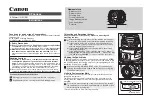A
PPENDIX
A. G
LOSSARY
P
AGE
23
4
Using External Triggering, Flash and Shutter Signals
Note:
.2.3
External flash and shutter control devices can be connected to cameras
with Enhanced Control headers only (PL-A633, PL-A634, PL-A653,
er
puts the camera into a trigger mode and begins to
as a software trigger. However, due to operating system and interface
delays, the minimal response time will be 15 ms with possible delays greater than 60
ms depending on the system configuration.
vided to the PixeLINK API functions represent the
. The delays are accurate to one decimal
a will start the exposure.
PL-A654).
PixeLINK cameras with Enhanced Control headers can receive external triggering signals
and can issue flash and shutter timing controls. These signals are controlled by the
PixeLINK API functions
PimMegaReturnFrameAfterTrigger
and
PimMegaReturnStillFrame
.
•
PimMegaReturnFrameAfterTrigg
capture a still image no more than 90 µs after an external trigger signal is detected.
•
PimMegaReturnStillFrame
returns a still frame immediately after being called and can
be used
Flash and shutter timing controls pro
delay in milliseconds following the trigger signal
place (0.1 ms). It is important to note that negative numbers are allowed. In the case
where a negative delay is used with an external trigger, the timing signals occur in order.
For example, with a flash delay of –15 ms and shutter delay of –5 ms, on receipt of the
trigger signal the flash signal will be fired immediately, followed 10 ms later by the
shutter signal. 5 ms after the shutter, the camer
The shutter timing signals also include a shutter close delay to close an external shutter
following an exposure.
PixeLINK
PL-A630 to PL-A660 Series Cameras
Megapixel FireWire Camera
System Guide
Copyright © 2000–2004 PixeLINK
All Rights Reserved


















